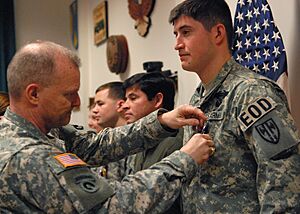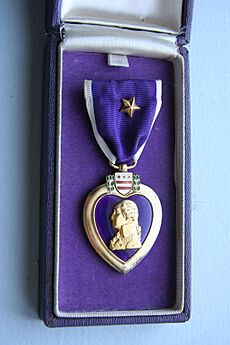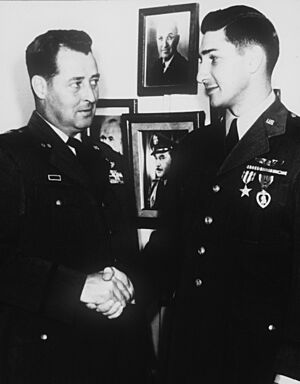Purple Heart facts for kids
Quick facts for kids Purple Heart |
|
|---|---|
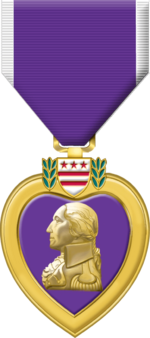
|
|
| Awarded for | Obverse profile of George Washington |
| Presented by |
|
The Purple Heart is a special United States military decoration. It is given to members of the U.S. military who are wounded or killed while serving. This award is given in the name of the President.
The Purple Heart is the oldest military award still given to U.S. military members. Its history goes back to the Badge of Military Merit. This original badge was shaped like a heart and made of purple cloth. Today, the National Purple Heart Hall of Honor is in New Windsor, New York.
Contents
The Purple Heart: A Brief History
The very first Purple Heart was called the Badge of Military Merit. It was created by George Washington on August 7, 1782. At that time, Washington was the leader of the Continental Army during the American Revolutionary War. He ordered the award from his headquarters in Newburgh, New York.
Washington personally gave the Badge of Military Merit to only three soldiers. He also allowed his officers to give out the badges when needed. Even though the award was never officially stopped, it wasn't given out again for a long time. People didn't suggest bringing it back until after World War I.
Bringing the Purple Heart Back
In 1927, Army Chief of Staff General Charles Pelot Summerall wanted to bring back the Badge of Military Merit. A plan was sent to Congress, but it didn't pass.
However, in 1931, General Douglas MacArthur took over as Army Chief of Staff. He secretly started working on a new design for the medal. Elizabeth Will, an Army expert in heraldry (the study of symbols and coats of arms), was chosen to redesign the medal. She created the design we see today. It shows a profile of George Washington. The new Purple Heart was officially brought back on February 22, 1932. This date was the 200th birthday of George Washington.
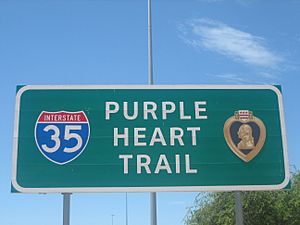
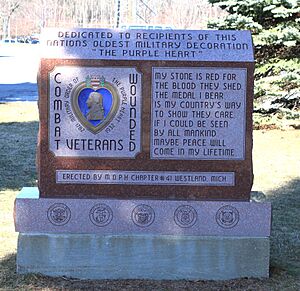
The rules for the Purple Heart were announced on February 22, 1932. Soldiers who had received certain awards for being wounded after April 5, 1917, could apply for it. This date was just before the United States entered World War I. General MacArthur was the first person to receive the new Purple Heart.
Changes Over Time
During the early part of World War II, the Purple Heart was given for both wounds and for doing a great job. But later, a new award called the Legion of Merit was created. After that, the Purple Heart was only given for wounds received in action.
In December 1942, the award was made available to all branches of the military. This meant the United States Army, United States Navy, United States Air Force, and others could all award it. The rules were made the same for everyone.
Some soldiers wounded in earlier wars, like the American Civil War or the Spanish–American War, also received the Purple Heart. This was because the original rules allowed any soldier wounded in a conflict to apply. They just had to be alive and prove they needed medical treatment for their wound.
Over the years, the rules for the Purple Heart have been updated. In 1962, it was allowed for those wounded or killed while serving with friendly foreign forces. In 1984, it was expanded to include wounds from terrorist attacks or while serving in peacekeeping missions. In 1985, it was also allowed for wounds from "friendly fire" (when a soldier is accidentally wounded by their own side) during battle.
Many Medals Made
During World War II, over 1.5 million Purple Heart medals were made. Many were prepared because a large number of casualties were expected from the planned invasion of Japan. Even after the war, nearly 500,000 medals were left over. The total number of American military casualties in the 70 years after World War II (including the Korean War and Vietnam War) did not use up all these extra medals.
In 2000, there were still 120,000 Purple Hearts in stock. This allowed military units in places like Iraq and Afghanistan to give the medals right away to soldiers wounded in the field. Since 2000, thousands more Purple Hearts have been ordered. These new medals are exactly like the ones made in the 1940s.
Purple Heart Statistics
Here are some estimated numbers of Purple Hearts given out:
- World War I: 320,518
- World War II: 1,076,245
- Korean War: 118,650
- Vietnam War: 351,794
- Persian Gulf War: 607
- Afghanistan War: 12,534 (as of November 18, 2018)
- Iraq War: 35,411 (as of November 18, 2018)
- Operation Inherent Resolve: 76 (as of May 4, 2020)
- United Nations Multidimensional Integrated Stabilization Mission in Mali, MINUSMA super camp attack: 2 (as of April 14, 2018)
Every year, August 7 is known as "National Purple Heart Day."
Who Gets the Purple Heart?

The Purple Heart is given to any U.S. Armed Forces member who is wounded or killed while serving. This applies to actions that happened after April 5, 1917.
Here are some examples of situations where a Purple Heart can be awarded:
- When someone is hurt in a fight against an enemy of the United States.
- When someone is hurt in a fight against another country's armed forces.
- When serving with friendly foreign forces fighting an armed conflict, even if the U.S. is not directly involved.
- When someone is hurt because of an act by an enemy or opposing force.
- When someone is hurt because of an act by a hostile foreign force.
The Purple Heart is different from most other awards. You don't get "recommended" for it. Instead, if you meet the specific rules, you are "entitled" to it. If a person receives more than one Purple Heart, they don't get a new medal each time. Instead, they wear an oak leaf cluster (for the Army, Air Force, and Space Force) or a 5/16 inch star (for the Navy, Marine Corps, and Coast Guard) on their medal ribbon.
What Counts as a Wound?
A "wound" means an injury to any part of the body caused by an outside force. This injury must have happened under one of the conditions listed above. The injury doesn't have to be a visible cut or bruise. However, it must have needed treatment by a medical officer. Records of the treatment must also be officially kept.
The most important thing commanders consider is how much the enemy caused the injury. Being in combat is necessary, but it's not the only reason for the award. The Purple Heart is not given for injuries that happen outside of combat.
Injuries that do qualify for the Purple Heart include:
- Injuries from enemy bullets, shrapnel, or other things caused by enemy action.
- Injuries from enemy land mines, naval mines, or booby traps.
- Injuries from enemy chemical, biological, or nuclear agents.
- Injuries from vehicle or aircraft accidents caused by enemy fire.
- Concussion injuries from enemy explosions.
Injuries that do not qualify for the Purple Heart include:
- Frostbite or trench foot.
- Heat stroke.
- Food poisoning not caused by enemy agents.
- Chemical, biological, or nuclear agents not released by the enemy.
- Battle fatigue or post-traumatic stress disorders.
- Diseases not directly caused by enemy agents.
- Accidents (like explosions, aircraft crashes, or vehicle accidents) not caused by enemy action.
- Self-inflicted wounds (unless in the heat of battle and not due to carelessness).
- Injuries from parachute jumps not caused by enemy action.
Sometimes, even if an injury seems to meet the rules, commanders look at the full situation. For example, if someone is hurt while parachuting from an aircraft shot down by enemy fire, they would get the award. Also, if someone is hurt by "friendly fire" during the "heat of battle," they will receive the Purple Heart. This is true as long as the "friendly" shot was meant to hit the enemy. However, if someone is hurt because they were careless, like walking into a known minefield, they would not get the award.
Animals are usually not eligible for the Purple Heart. But there have been rare cases where military animals received the award. Examples include the horse Sergeant Reckless during the Korean War and the dog Sergeant Stubby during World War I.
Who Used to Be Eligible?
From 1942 to 1997, some non-military people could also get the Purple Heart. This included government employees, Red Cross workers, and war correspondents. About 100 non-military people received the award. One famous example was newspaperman Ernie Pyle. He received a Purple Heart after being killed by Japanese machine gun fire in World War II.
However, in 1997, a law was passed that stopped future awards of the Purple Heart to non-military people. Now, civilian employees of the U.S. Department of Defense who are killed or wounded by hostile action can receive the new Secretary of Defense Medal for the Defense of Freedom. This award was created after the September 11 attacks in 2001.
What the Purple Heart Looks Like
The Purple Heart medal is shaped like a heart and is about 1 and 3/8 inches wide. It is purple and gold. On the front, it has a profile of General George Washington. Above the heart, there is a shield from the Coat of Arms of George Washington. This shield is white with two red bars and three red stars. It is surrounded by green leaves.
On the back of the medal, there is a raised bronze heart with the words "FOR MILITARY MERIT" below the coat of arms and leaves.
The ribbon for the medal is also 1 and 3/8 inches wide. It has a wide purple stripe in the middle, with a thin white stripe on each side.
How the Purple Heart Is Given Out
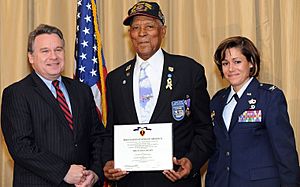
Today, active duty military members receive the Purple Heart after their commanders recommend it. The recommendation explains the injury and how it happened. The award is usually given by a high-ranking officer. Even though the award is considered automatic for combat wounds, each case is reviewed to make sure the wounds were caused by enemy action.
Modern Purple Heart awards are recorded in both paper and electronic military records. The service member receives an official certificate.
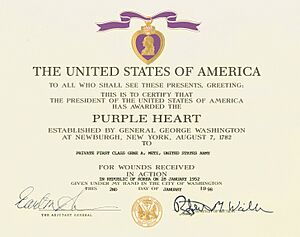
In past wars, like the Vietnam War, Korean War, and World War II, the Purple Heart was often given out right away. Sometimes, these awards were not fully recorded in official files. This happened due to mistakes or because soldiers quickly returned to their units. For example, a general might visit a hospital and pin medals on wounded soldiers without official records being kept.
If veterans need to get a Purple Heart that was not officially recorded, they can apply through the National Personnel Records Center. After reviewing their records, the award can be given.
Famous People Who Received the Purple Heart
Many brave individuals have received the Purple Heart. Here are some of them:
- James Arness, actor
- John Basilone, U.S. Marine Corps, WWII, Medal of Honor recipient
- Rocky Bleier, professional football player
- Charles Bronson, actor
- Art Carney, actor
- Kyle Carpenter, U.S. Marine Corps Medal of Honor recipient
- Dan Crenshaw, U.S. Representative and former Navy SEAL
- Bob Dole, former U.S. Senator and presidential candidate
- Desmond Doss, WWII, Medal of Honor recipient
- Tammy Duckworth, U.S. Senator and Iraq War veteran
- Charles Durning, actor
- James Garner, actor, 2 awards
- Salvatore Giunta, Medal of Honor recipient, Afghanistan War veteran
- Calvin Graham, U.S. Navy, WWII, youngest Purple Heart recipient (12 years old)
- David Hackworth, U.S. Army, writer, 8 awards
- Daniel Inouye, former U.S. Senator, Medal of Honor recipient, WWII
- John F. Kennedy, U.S. Navy, WWII, 35th President of the United States
- John Kerry, former U.S. Secretary of State, 3 awards
- Ron Kovic, U.S. Marine Corps, writer and activist
- Douglas MacArthur, General of the U.S. Army, Medal of Honor recipient
- Lee Marvin, actor
- John McCain, U.S. Navy, POW (Vietnam), former U.S. Senator
- Doris Miller, Navy Cross recipient for actions at attack on Pearl Harbor
- Audie Murphy, Medal of Honor recipient, actor, 3 awards
- Michael P. Murphy Medal of Honor recipient, Navy SEAL
- George S. Patton, U.S. Army general
- Colin Powell, U.S. Army general, former U.S. Secretary of State
- Ernie Pyle, WWII war correspondent
- Sergeant Reckless, U.S. Marine Corps war horse
- Theodore Roosevelt Jr., U.S. Army, Medal of Honor recipient, son of President Theodore Roosevelt
- Norman Schwarzkopf Jr., U.S. Army general during Operation Desert Storm
- Rod Serling, screenwriter and TV host
- Tim Sheehy, retired Navy SEAL, U.S. Senator from Montana
- Spencer Stone, U.S. Air Force staff sergeant, stopped the 2015 Thalys train attack
- Sergeant Stubby, Army K9 WWI
- Pat Tillman, U.S. Army Ranger, professional football player
- Matt Urban, U.S. Army, Medal of Honor recipient, 7 awards
- Kurt Vonnegut, author
- Jim Webb, Marine Corps, former U.S. Senator
- Richard Winters, U.S. Army major, subject of Band of Brothers
- Chuck Yeager, U.S. Air Force general
Most Purple Heart Awards
Some individuals have received the Purple Heart many times for multiple wounds.
- Ten Purple Hearts:
- Charles D. Barger, U.S. Army: World War I
- William G. White, U.S. Army: World War II (9), Korean War (1)
- Curry T. Haynes, U.S. Army: Vietnam War
- Nine Purple Hearts:
- Albert L. Ireland, U.S. Marine Corps: World War II (5), Korean War (4)
- Eight Purple Hearts:
- Bobbie E. Brown, U.S. Army: World War II
- John J. Duffy, U.S. Army: Vietnam War
- Robert T. Frederick, U.S. Army: World War II
- David Hackworth, U.S. Army: Korean War (3), Vietnam War (5)
- Joe Hooper, U.S. Army: Vietnam War
- Robert L. Howard, U.S. Army: Vietnam War
- William Waugh, U.S. Army: Vietnam War
- Richard J. Buck, U.S. Army: Korean War (4), Vietnam War (4)
- William L. Russell, U.S. Army: World War II
- Seven Purple Hearts:
- Matt Urban, U.S. Army: World War II
- David A. Christian, U.S. Army: Vietnam War
- Randy McConnell, U.S. Army: Vietnam War
- Olinto M. Barsanti, U.S. Army: World War II (4), Korean War (1), Vietnam War (2)
- Lionel C. McGarr, U.S. Army: World War II (5), Korean War (2)
- Robert L. Schweitzer, U.S. Army: Vietnam War
See also
 In Spanish: Corazón Púrpura para niños
In Spanish: Corazón Púrpura para niños
- DEA Purple Heart Award
- Gold Star Lapel Button
- Law Enforcement Purple Heart
- Secretary of Defense Medal for the Defense of Freedom
- Texas Purple Heart Medal
- Wound stripe
- List of wound decorations


